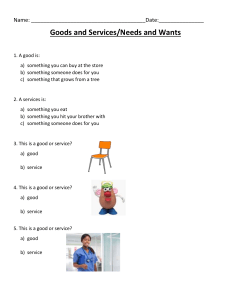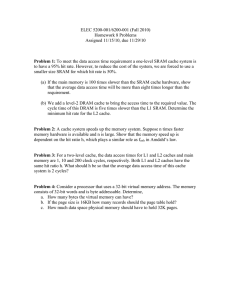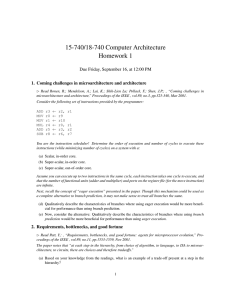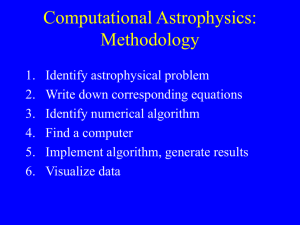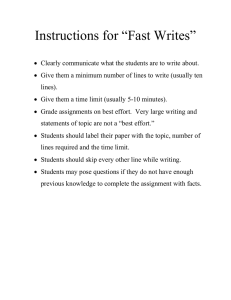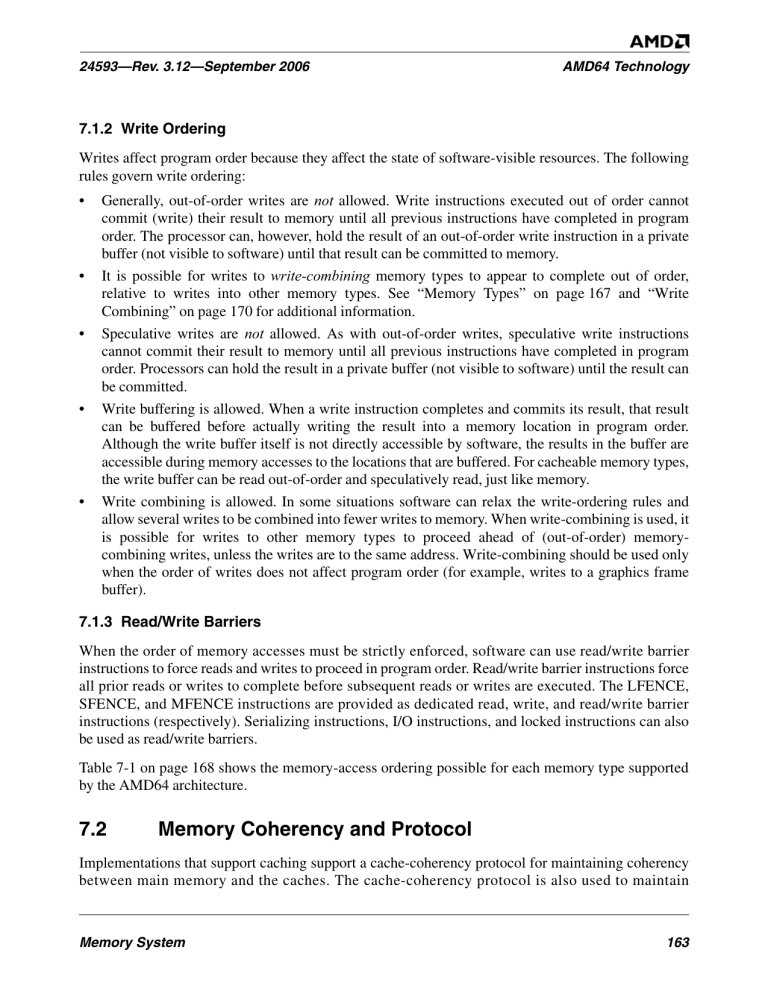
24593—Rev. 3.12—September 2006 AMD64 Technology 7.1.2 Write Ordering Writes affect program order because they affect the state of software-visible resources. The following rules govern write ordering: • • • • • Generally, out-of-order writes are not allowed. Write instructions executed out of order cannot commit (write) their result to memory until all previous instructions have completed in program order. The processor can, however, hold the result of an out-of-order write instruction in a private buffer (not visible to software) until that result can be committed to memory. It is possible for writes to write-combining memory types to appear to complete out of order, relative to writes into other memory types. See “Memory Types” on page 167 and “Write Combining” on page 170 for additional information. Speculative writes are not allowed. As with out-of-order writes, speculative write instructions cannot commit their result to memory until all previous instructions have completed in program order. Processors can hold the result in a private buffer (not visible to software) until the result can be committed. Write buffering is allowed. When a write instruction completes and commits its result, that result can be buffered before actually writing the result into a memory location in program order. Although the write buffer itself is not directly accessible by software, the results in the buffer are accessible during memory accesses to the locations that are buffered. For cacheable memory types, the write buffer can be read out-of-order and speculatively read, just like memory. Write combining is allowed. In some situations software can relax the write-ordering rules and allow several writes to be combined into fewer writes to memory. When write-combining is used, it is possible for writes to other memory types to proceed ahead of (out-of-order) memorycombining writes, unless the writes are to the same address. Write-combining should be used only when the order of writes does not affect program order (for example, writes to a graphics frame buffer). 7.1.3 Read/Write Barriers When the order of memory accesses must be strictly enforced, software can use read/write barrier instructions to force reads and writes to proceed in program order. Read/write barrier instructions force all prior reads or writes to complete before subsequent reads or writes are executed. The LFENCE, SFENCE, and MFENCE instructions are provided as dedicated read, write, and read/write barrier instructions (respectively). Serializing instructions, I/O instructions, and locked instructions can also be used as read/write barriers. Table 7-1 on page 168 shows the memory-access ordering possible for each memory type supported by the AMD64 architecture. 7.2 Memory Coherency and Protocol Implementations that support caching support a cache-coherency protocol for maintaining coherency between main memory and the caches. The cache-coherency protocol is also used to maintain Memory System 163 AMD64 Technology 24593—Rev. 3.12—September 2006 coherency between all processors in a multiprocessor system. The cache-coherency protocol supported by the AMD64 architecture is the MOESI (modified, owned, exclusive, shared, invalid) protocol. The states of the MOESI protocol are: • • • • • Invalid—A cache line in the invalid state does not hold a valid copy of the data. Valid copies of the data can be either in main memory or another processor cache. Exclusive—A cache line in the exclusive state holds the most recent, correct copy of the data. The copy in main memory is also the most recent, correct copy of the data. No other processor holds a copy of the data. Shared—A cache line in the shared state holds the most recent, correct copy of the data. Other processors in the system may hold copies of the data in the shared state, as well. If no other processor holds it in the owned state, then the copy in main memory is also the most recent. Modified—A cache line in the modified state holds the most recent, correct copy of the data. The copy in main memory is stale (incorrect), and no other processor holds a copy. Owned—A cache line in the owned state holds the most recent, correct copy of the data. The owned state is similar to the shared state in that other processors can hold a copy of the most recent, correct data. Unlike the shared state, however, the copy in main memory can be stale (incorrect). Only one processor can hold the data in the owned state—all other processors must hold the data in the shared state. Figure 7-2 on page 165 shows the general MOESI state transitions possible with various types of memory accesses. This is a logical software view, not a hardware view, of how cache-line state transitions. Instruction-execution activity and external-bus transactions can both be used to modify the cache MOESI state in multiprocessing or multi-mastering systems. 164 Memory System 24593—Rev. 3.12—September 2006 AMD64 Technology Reset INVD, WBINVD Read Hit Probe Write Hit Exclusive Invalid Probe W rite Hit Read M Pro Wr ite Pro P Hit Bm ) Shared Probe Read Owned Read Hit Probe Read Hit (W Hit rob ss ory te Wri a e eR Mi Wr ite em be it dH be Hit Write iss, Sha red Read Miss, Exclusive Hit Modified Write Hit Read Hit Write Hit Write Hit Read Hit Probe Read Hit 513-212.eps Figure 7-2. MOESI State Transitions To maintain memory coherency, external bus masters (typically other processors with their own internal caches) need to acquire the most recent copy of data before caching it internally. That copy can be in main memory or in the internal caches of other bus-mastering devices. When an external master has a cache read-miss or write-miss, it probes the other mastering devices to determine whether the most recent copy of data is held in any of their caches. If one of the other mastering devices holds the most recent copy, it provides it to the requesting device. Otherwise, the most recent copy is provided by main memory. Memory System 165 AMD64 Technology 24593—Rev. 3.12—September 2006 There are two general types of bus-master probes: • • Read probes indicate the external master is requesting the data for read purposes. Write probes indicate the external master is requesting the data for the purpose of modifying it. Referring back to Figure 7-2 on page 165, the state transitions involving probes are initiated by other processors and external bus masters into the processor. Some read probes are initiated by devices that intend to cache the data. Others, such as those initiated by I/O devices, do not intend to cache the data. Some processor implementations do not change the data MOESI state if the read probe is initiated by a device that does not intend to cache the data. State transitions involving read misses and write misses can cause the processor to generate probes into external bus masters and to read main memory. Read hits do not cause a MOESI-state change. Write hits generally cause a MOESI-state change into the modified state. If the cache line is already in the modified state, a write hit does not change its state. The specific operation of external-bus signals and transactions and how they influence a cache MOESI state are implementation dependent. For example, an implementation could convert a write miss to a WB memory type into two separate MOESI-state changes. The first would be a read-miss placing the cache line in the exclusive state. This would be followed by a write hit into the exclusive cache line, changing the cache-line state to modified. 7.2.1 Special Coherency Considerations In some cases, data can be modified in a manner that is impossible for the memory-coherency protocol to handle due to the effects of instruction prefetching. In such situations software must use serializing instructions and/or cache-invalidation instructions to guarantee subsequent data accesses are coherent. An example of this type of a situation is a page-table update followed by accesses to the physical pages referenced by the updated page tables. The following sequence of events shows what can happen when software changes the translation of virtual-page A from physical-page M to physical-page N: 1. Software invalidates the TLB entry. The tables that translate virtual-page A to physical-page M are now held only in main memory. They are not cached by the TLB. 2. Software changes the page-table entry for virtual-page A in main memory to point to physicalpage N rather than physical-page M. 3. Software accesses data in virtual-page A. During Step 3, software expects the processor to access the data from physical-page N. However, it is possible for the processor to prefetch the data from physical-page M before the page table for virtualpage A is updated in Step 2. This is because the physical-memory references for the page tables are different than the physical-memory references for the data. Because the physical-memory references are different, the processor does not recognize them as requiring coherency checking and believes it is safe to prefetch the data from virtual-page A, which is translated into a read from physical page M. 166 Memory System
